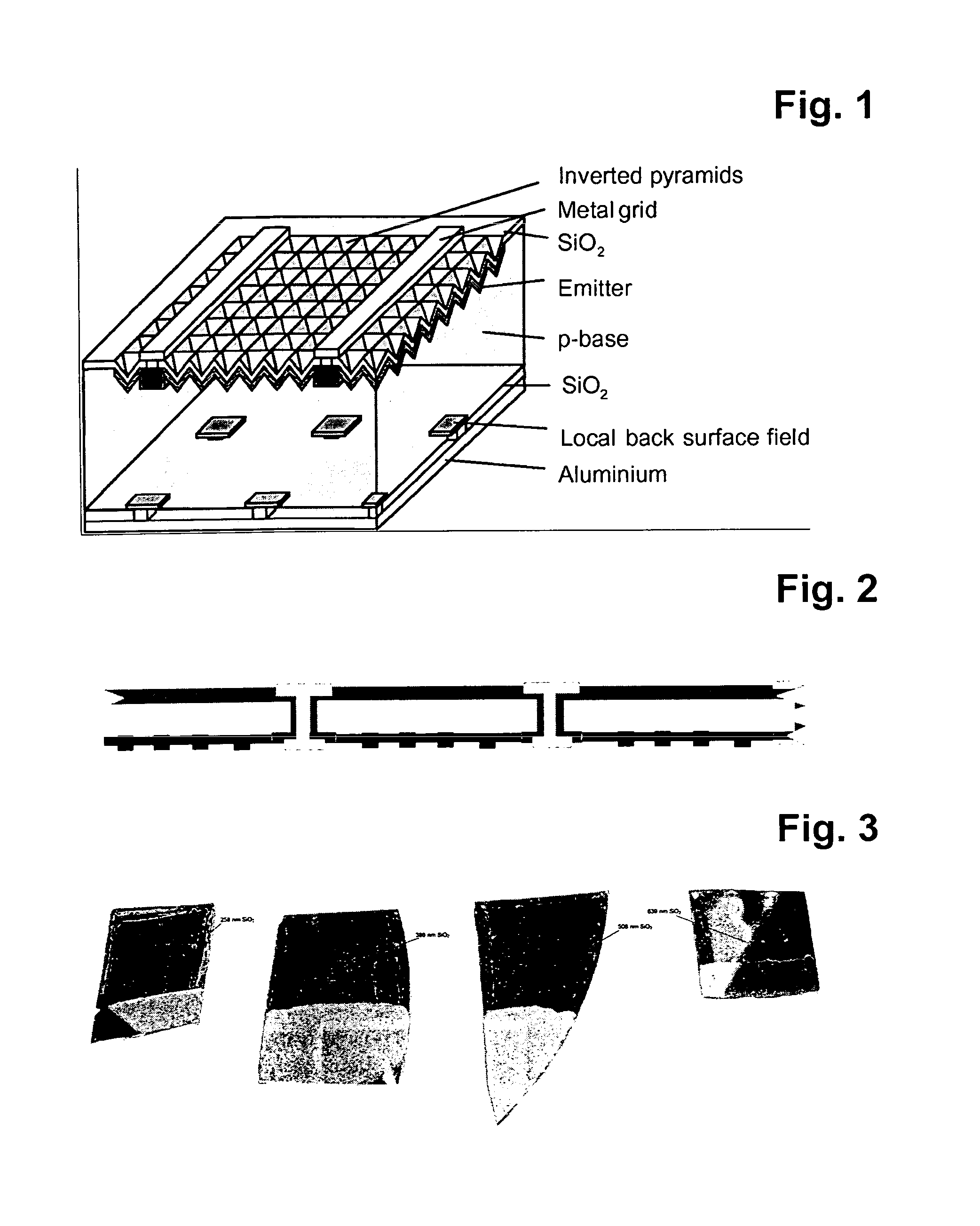Aluminium oxide-based metallisation barrier
a technology of aluminium oxide and a metallisation barrier, which is applied in the direction of liquid/solution decomposition chemical coating, semiconductor/solid-state device details, coatings, etc., can solve the problem of increasing the pressure of conventional full-area metallisation on the back, the surface recombination speed of the strongly aluminium-doped layer is very high, and cannot be further reduced as desired by means of existing conventional technology
- Summary
- Abstract
- Description
- Claims
- Application Information
AI Technical Summary
Benefits of technology
Problems solved by technology
Method used
Image
Examples
example 1
[0068]In accordance with Example 4 from the European patent application with the application number 11 001 920.5: 3 g of salicylic acid and 1 g of acetylacetone in 25 ml of isopropanol and 25 ml of diethylene glycol monoethyl ether are initially introduced in a 100 ml round-bottomed flask. 4.9 g of aluminium tri-sec-butoxide are added to the solution, and the mixture is stirred for a further 10 minutes. 5 g of acetic acid are added in order to neutralise the butoxide and adjust the pH of the ink, and the mixture is again stirred for 10 minutes. 1.7 g of water are added in order to hydrolyse the partially protected aluminium alkoxide, and the slightly yellow solution is stirred for 10 minutes and left to stand in order to age. The solids content can be increased to 6% by weight. The ink exhibits a stability of >3 months with ideal coating properties and efficient drying (cf. FIGS. 1 and 2 in the above-mentioned patent application 11 001 920.5).
[0069]In order to evaluate the metal-bar...
example 2
[0070]In order to investigate a possible barrier action of SiO2, 4 wafer pieces (Cz, p-type, polished on one side, 10 Ω*cm) are coated with SiO2 in the sol-gel process by spin coating (optionally with multiple coating, if necessary, where each layer is thermally compacted in advance as described in Example 1) and various layer thicknesses, and the sol applied is thermally compacted (30 min at 450° C., as described in Example 1). Half of each wafer is etched free by an HF dip.
[0071]FIG. 3 shows photographs of the wafer pieces before metallisation.
[0072]An aluminium metal paste is subsequently applied to the entire surface of the wafer in a layer thickness of 20 μm by means of a hand coater, and the wafer treated in this way is fired for 100 s in a belt furnace having four zones (T set points: 850 / 800 / 800 / 800° C.). The aluminium paste is subsequently removed by etching with a phosphoric acid (85%) / nitric acid (69%) / acetic acid (100%) mixture (in v / v: 80 / 5 / 5, remainder water). The SiO2...
example 3
[0077]3 wafer pieces (Cz, p-type, polished on one side, 10 Ω*cm) are coated with a sol-gel-based Al2O3 layer by spin coating to give various layer thicknesses (optionally with multiple coating, if necessary, where each layer is thermally compacted in advance, as described under Example 1). The sol layer is thermally compacted (30 min at 450° C., as described under Example 1), and half of the Al2O3 layer is subsequently removed by etching with dilute HF solution.
[0078]FIG. 5 shows photographs of the wafer pieces before metallisation.
[0079]An aluminium metal paste is subsequently applied to the entire surface of the wafer in a layer thickness of 20 μm by means of a hand coater, and the wafer is fired for 100 s in a belt furnace having four zones (T set points: 850 / 800 / 800 / 800° C.). After the firing process, the aluminium paste is removed by etching with a phosphoric acid (85%) / nitric acid (69%) / acetic acid (100%) mixture (in v / v: 80 / 5 / 5, remainder water). The Al2O3 layer and any paras...
PUM
| Property | Measurement | Unit |
|---|---|---|
| thickness | aaaaa | aaaaa |
| thickness | aaaaa | aaaaa |
| temperatures | aaaaa | aaaaa |
Abstract
Description
Claims
Application Information
 Login to View More
Login to View More - R&D
- Intellectual Property
- Life Sciences
- Materials
- Tech Scout
- Unparalleled Data Quality
- Higher Quality Content
- 60% Fewer Hallucinations
Browse by: Latest US Patents, China's latest patents, Technical Efficacy Thesaurus, Application Domain, Technology Topic, Popular Technical Reports.
© 2025 PatSnap. All rights reserved.Legal|Privacy policy|Modern Slavery Act Transparency Statement|Sitemap|About US| Contact US: help@patsnap.com



